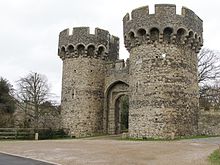Cooling Castle
Cooling Castle was built in the 1380s by John Cobham on the edge of the marshes in the village of Cooling , about ten kilometers north of Rochester in the English county of Kent . Today it is over three kilometers from the coast. It was besieged by Thomas Wyatt during the Wyatt Conspiracy in 1554. Lord Cobham surrendered after a brief resistance. Although he stated that he had surrendered to someone stronger, he had previously sympathized with Wyatt and was therefore imprisoned for a short time. The castle later also belonged to the lollard leader John Oldcastle - later executed for his faith and model for William Shakespeare's Falstaff - through marriage to Joan Oldcastle, 4th Baroness Cobham .
In the 1990s the property belonged to the Rochester bridge keepers. The later built residential buildings of the castle are still in use today; In 2006 they belonged to the musician Jools Holland . The main part of the castle is a ruin; inside there is a private house. The gatehouse is in good condition and can be seen from the street. Cooling Castle's sheds are used to host weddings and other events.
English Heritage has listed the castle as a historical building of the first degree and in 2009 put it on the “Heritage-at-Risk” list.
Individual evidence
- ^ A b c Valerie Elliott: Jools Holland's Cooling Castle joins band of at-risk monuments . The Times. June 23, 2009. Retrieved March 13, 2010.
- ^ English Heritage's Heritage at Risk Register - Cooling Castle . Retrieved on February 27, 2015. ( Page no longer available , search in web archives ) Info: The link was automatically marked as defective. Please check the link according to the instructions and then remove this notice.
Web links
- Cooling Castle . Castles and Fortifications of England and Wales
- Cooling Castle Barn website
- Cooling Castle map and aerial view. Google Maps.
Coordinates: 51 ° 27 ′ 19.6 ″ N , 0 ° 31 ′ 23.1 ″ E
